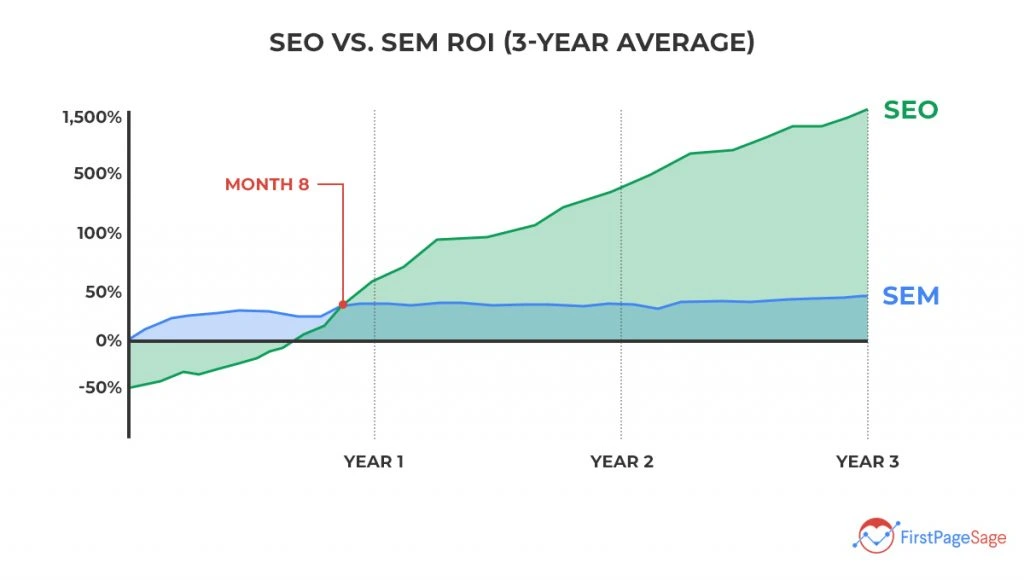Let’s start with the basics: paid and organic search results are found on the same SERP (search engine results page). The majority of paid results feature before any organic results.
So why would you invest in one and not the other? Well, it can depend on when you need to demonstrate ROI.
SEO (search engine optimisation) is a longer-term play. And while the time to ROI can depend largely on your brand, your website and the competitive landscape, even Google suggests SEOs will need 4 to 12 months.
Paid search, SEM (search engine marketing) or Google Ads, on the other hand, is your opportunity for short-term visibility, traffic and leads.
I want to discuss the power of investing in both SEO and SEM.
Committing to your target search terms with an SEO & SEM approach
When any business wants to generate traffic and revenue from search, they need to identify what their audience is searching for and their intent when doing so.
Keyword research is often one of the first steps to identify your ideal target search terms. And while I’d warn you about focusing solely on a narrow group of search terms as opposed to keyword topics, having your targets is a great way of monitoring your visibility and search performance.
The screenshot below is courtesy of a client dashboard within SEOMonitor. It’s assessing 20 nominated, high-value search terms and indicates two very important numbers:
Search Data: 65k searches in Australia this month.
SERP Data: 81% of the total searches this month are projected to go to organic results.

So if our client was investing solely in SEO, our role and responsibility is to generate as much organic traffic as possible from the available 52,650 organic clicks. It would also mean that the remaining 12,350 searches for these highly valuable search terms are out of play for the client. These clicks, I should note, are made up of paid search results and other Google features or zero-clicks, too.
Thankfully though, the client does invest in SEM as well as SEO in order to leverage every available search for these identified terms.
It’s worth nothing that we’re assuming in the above scenario that you have a prominent position in the organic search results. For those who don’t have a lot of organic visibility for their target terms, the benefit of paid search is even more important in the early months.
You see, while you wait for your SEO investment to begin generating the visibility you need, paid search can get you that visibility immediately. So even if you don’t want to combine SEO and SEM for your target search terms, I’d strongly consider utilising paid initially to ensure you have visibility.

Guide SEO strategy through SEM insights
If you’re familiar with Google Analytics (and you should be) then you’re looking at how organic traffic is influencing your conversions and revenue.
What Google Analytics won’t tell you is what specific search terms or keywords from organic generated those conversions. That powerful information is what you can get from your Google Ads dashboard, if you’re running a paid search campaign.
There will be terms that get more clicks but don’t convert as well. Without this data, the chances are that you’ve used the higher-volume term to optimise for organically. And that may not be the best strategy.
A paid search campaign will also see Google serve your ad to a range of ‘broad match’ or related search terms that you may not have considered. This is more insight that can help guide a better SEO strategy.
Glean user intent from SEO for enhanced ad copy
Search intent has a big influence on keyword research for SEO because we don’t just want to be visible – we want users to take action and click our result. And your objective for paid search or SEM is the same.
This is where SEO research can be invaluable in guiding your ad copy.
With billions of searches and clicks every day, it can be said Google has a very good idea of what a searcher is looking for when they perform a specific search. So with an SEO’s understanding of the top organic results, you can analyse intent along with meta titles and meta descriptions to help craft ads that increase click-through rates and generally perform better.
Test new markets with PPC campaigns
A not-so-common use case for paid search or SEM is testing out new markets for your business.
If you’re looking to expand your business to a new city or neighbourhood, consider launching some test landing pages for the new locations that are on the table. The call to action could be as simple as a ‘register your interest’ form, if you think that wouldn’t be discouraging. Or you could provide a unique number and contact form.
After a couple of months, you’ll be able to identify if any of the proposed locations show higher click-through rates from search ads and convert better.
It shouldn’t necessarily be the insight that makes the final decision, but it’s great for another layer of information to help form your decision.
Experience the benefits of a combined approach
While the debate between SEO and SEM often positions them as separate entities, the reality is that they appear on the same SERP and should work hand in hand. As I’ve discussed, investing in both can lead to a richer, more informed and ultimately more successful search marketing strategy. So next time you’re planning your search strategy, remember: why choose one when both can propel you further?

